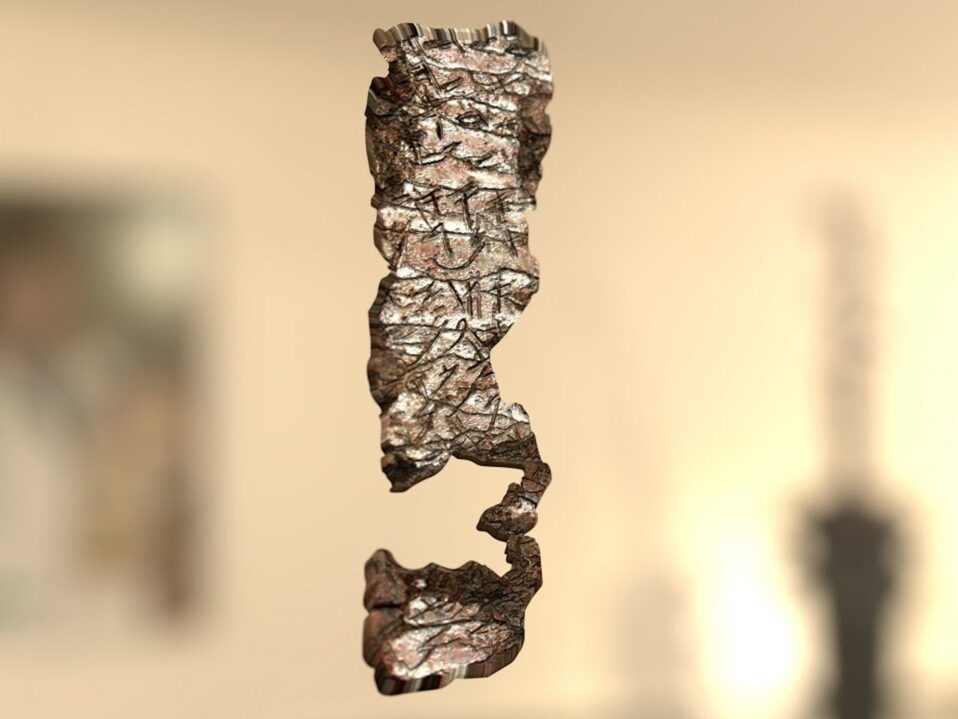There are a number of archaeological findings in Israel connected to the Old Testament, but three specific examples are especially worth highlighting here: (1) the Ketef Hinnom Scrolls; (2) the Tel Dan Inscription; and (3) the Mesha Stele.
Ketef Hinnom Scrolls: Archaeologists excavating a tomb complex from the seventh to sixth century B.C. discovered two small silver scrolls. Both contain the earliest biblical text discovered anywhere. One preserves a portion of the Aaronic blessing from Numbers 6:24-26, although with slight differences. The other shares language parallel to several passages within the Old Testament. These scrolls served as amulets worn around the neck of the deceased. Archaeologists dated them to the sixth century B.C. They reside in the Israel Museum in Jerusalem.
Tel Dan Inscription: Excavations at the ancient site of Dan uncovered three fragments of a stele dating to the ninth century B.C. Dan sits in northern Israel on the largest of the three headwaters of the Jordan River, the Dan Spring. The site received its name from the Tribe of Dan, who was forced to relocate from their allotted land in the Judean Shephelah and conquer the city of Laish, renaming it Dan. The inscription was in Aramaic and was likely erected by Hazael the king of Aram-Damascus who defeated the kings of Israel and Judah.
Within the inscription, the Aramean king boasts of his defeat of the king of Israel and the king of Judah, which he refers to as the king of the House of David. This part of the inscription is important for a couple of reasons. First, it shows that the kings of Judah traced their dynastic lineage back to a figure named David. Second, the Old Testament refers to the royal house of Judah as the House of David on many occasions. Within the biblical story, this language derives from God’s promise to David in 2 Samuel 7, to give him a “house” meaning a dynasty to sit on the throne in Jerusalem.
Mesha Stele: Also known as the Moabite Stone, this stele dates to the time of Jehoahz (c. 810-805 B.C). Written in Moabite, a Canaanite language akin to Hebrew, Mesha, king of Moab, tells how Chemosh, his god, helped him throw off the yoke the king of Israel and recover Moabite lands. Mesha references the end of the House of Omri, the dynasty of the northern kingdom of Israel to which Ahab belonged and was overthrown in the coup of Jehu. Mesha also liberated his lands from the House of David.
The Mesha inscription refers to the ruling dynasty of Judah as the House of David, like the Tel Dan Stele. It was discovered at Dhiban, Jordan (biblical Dibon). Researchers made a squeeze of the inscription, which is housed in the Louvre in Paris. Shortly after the squeeze was made, Bedouin destroyed the stele. While many of the pieces were recovered and are also housed in the Louvre, it affected the ability of researchers to read the inscription from the stone itself.
Archaeological discoveries like the ones mentioned above shed light on the world of the Bible. They provide crucial information for us to understand the past. These and other archaeological findings add new evidence and information to help us reconstruct the biblical world.
Marc Turnage is President/CEO of Biblical Expeditions. He is an authority on ancient Judaism and Christian origins. He has published widely for both academic and popular audiences. His most recent book, Windows into the Bible, was named by Outreach Magazine as one of its top 100 Christian living resources. Marc is a widely sought-after speaker and a gifted teacher. He has been guiding groups to the lands of the Bible—Israel, Jordan, Egypt, Turkey, Greece, and Italy—for over twenty years.
Website: WITBUniversity.com
Facebook: @witbuniversity
Podcast: Windows into the Bible Podcast




Comment(1)-





Sonia Williams says
May 16, 2023 at 2:45 amSuch wonderful treasures. It underscores the value of the Holy Lands.
Receive Devotionals and News Updates from Israel
Recent Posts
Victim of Terrorism: Giulia’s Story
The Mountain of God: The Temple Mount Through Time
Weekly Devotional: The Freedom of Trust
Torah Reading Devotional: Parashat Lech-Lecha (לֶךְ־לְךָ) “Go Forth”